How To Do A Spot Color In Photoshop
Introduction
This section explains how to prepare images that include spot data with raster-based epitome editing applications such equally Adobe Photoshop®. In society to print with white ink or varnish, you must have an ONYX profile (media model) properly configured for the use of spot data. To add spot color data to your image in PhotoShop, you demand to create a layer within the paradigm equally a new spot channel. It is possible to have more than one spot chemical element in an image, but each chemical element must be on the same spot aqueduct, and therefore have the same opacity level, or else ONYX Thrive will treat the saved document as a separation file. Since the Arizona printers with white ink or varnish support 2 spot channels, you tin create one spot channel for Spot 1 data and another for Spot 2 data. CMYK is the preferred image way as the actions required for spot data creation are simpler than those for RGB.
![]() NOTE
NOTE
You can use raster-based image editing applications other than Photoshop as long every bit it has the ability to create spot channels.
Purpose
When yous have a raster-based paradigm and need to take select areas of that epitome show up as white when the media is non-white or clear or translucent, you can prepare a spot channel for the white data in Photoshop.
About this task
The get-go stride in the white ink or varnish workflow is to prepare your source epitome to apply a spot ink channel. The spot information must be designed entirely on a separate channel (either as a spot channel layer or a custom spot color) to be recognized past the ONYX RIP. The proper noun you assign to this spot channel layer or custom spot color must exist Spot 1 or Spot ii and is the most of import function of preparing the file. This named aqueduct allows RIP-Queue to determine that the data in the source prototype needs to be output to the spot channel. In preparing your file, only you lot tin can define what you want to print with "white ink" or "varnish" every bit part of your design and assign the color as described in this document. Using your graphic application programme, the spot data tin be simple or circuitous and can range from vector shapes and text to halftone bitmap images.
New Spot Aqueduct Layer
Employ the following steps to create a new spot channel layer:
Procedure
- Open the desired file in PhotoShop (if the file is in RGB fashion, then convert it to CMYK fashion).
- Apply the desired choice tool (east.g. the Magic Wand) to select the area of the image yous wish to impress with white ink.
 Annotation
Annotation The image file used in this example is for illustration purposes only. For best results when working with text, we recommend that you utilize a vector-based program such as Adobe Illustrator.
- In PhotoShop, ensure that the Channels tab is visible (under the Window bill of fare click Channels to view the console).
- Click the arrow on the Channels tab to brandish the Channels carte du jour.
- Select New Spot Channel from the Channels menu to open the Add Spot Aqueduct dialog.
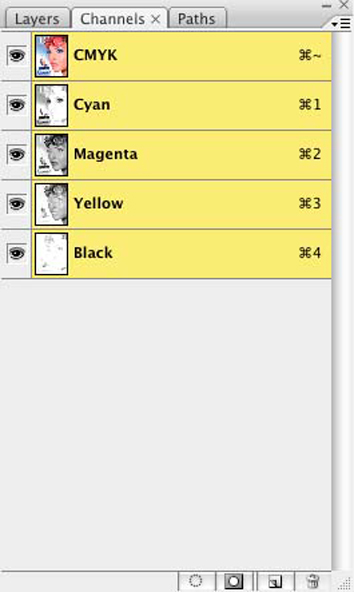 Add Spot Aqueduct
Add Spot Aqueduct 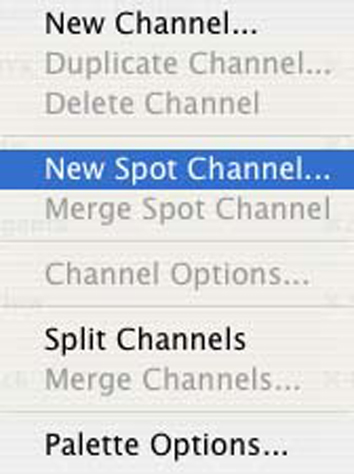
- Within the Add Spot Channel dialog, enter the post-obit data:
-
Name – Enter the name "Spot 1" or "Spot 2". This name is specifically reserved in RIP-Queue for this type of workflow, using any other name requires more than steps to make spot information addressed past the Rip software.
Note: For instructions on how to employ a naming convention other than Spot 1 or Spot ii, refer to the sub-department at the stop of this section "How to Proper noun Your Spot Data".
-
Opacity – Gear up the opacity to ten%
-
Edit the aqueduct COLOR by double-clicking on the swatch. Set the spot color in PhotoShop to a color like to the spot ink in your printer. Since white can exist hard to distinguish, this COLOR can be whatsoever value that volition help y'all encounter the design better.
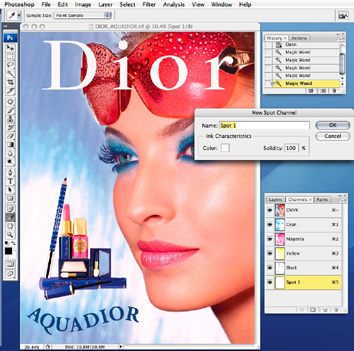 Select Spot Color
Select Spot Color 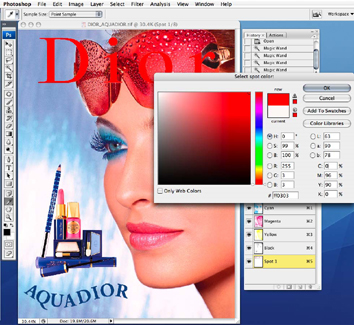 Change Spot Colour
Change Spot Colour -
- Click OK to relieve your changes and shut the Add Spot Channel dialog.
- You can create a overflowing layer in the same way by selecting the unabridged workspace (Select All) then add the spot aqueduct as described above. The example below shows what your workspace may await like with a 50% and 100% flood fill. If you need to see your image for editing purposes, simply turn off the visibility of the Spot Channel.
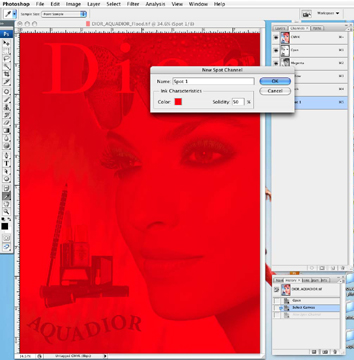 Alluvion fifty PSD
Alluvion fifty PSD 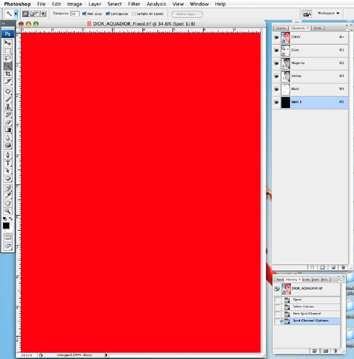 Flood 100 PSD
Flood 100 PSD - In some cases, it may be easier to select the area in which you don't want any white ink data and so select the changed.
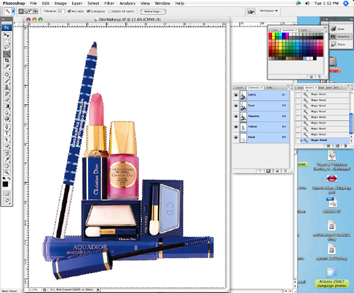 Select
Select 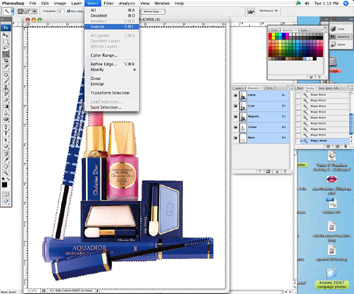 Select Changed
Select Changed - It is also possible to edit the spot channel much every bit you would whatsoever other information in a PhotoShop certificate, making employ of such tools as the Eraser.
- Salvage your image as a either a TIFF or PSD format file (meet the points below to determine the best format).
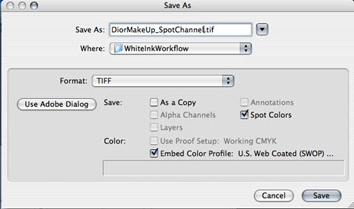 Save with Spot Option
Save with Spot Option -
If you intend to use this file in a vector-based program such every bit Illustrator, save it as a .PSD file in order for all aqueduct information to be carried over. The white spot color is printed in the order information technology appears in the Channels palette, with the spot channel press underneath CMYK information. Still, when exported as a .PSD to Illustrator, this data will appear above the image data. This is the correct format protocol for Illustrator.
-
Salvage every bit TIFF and ensure that the spot colors option is enabled if you program to bring this epitome straight into ONYX Thrive.
-
It is also possible and sometimes preferable to print directly from PhotoShop to Rip-Queue. For instructions on how to practice this, meet document provided on the ONYX website "Press From a Mac", which also contains information on printing from Windows-based systems.
-
Source: https://docs.cpp.canon/help?tsm=ODP000144-1.1EN.US&pageid=M104342.xml
Posted by: donnersily1998.blogspot.com

0 Response to "How To Do A Spot Color In Photoshop"
Post a Comment